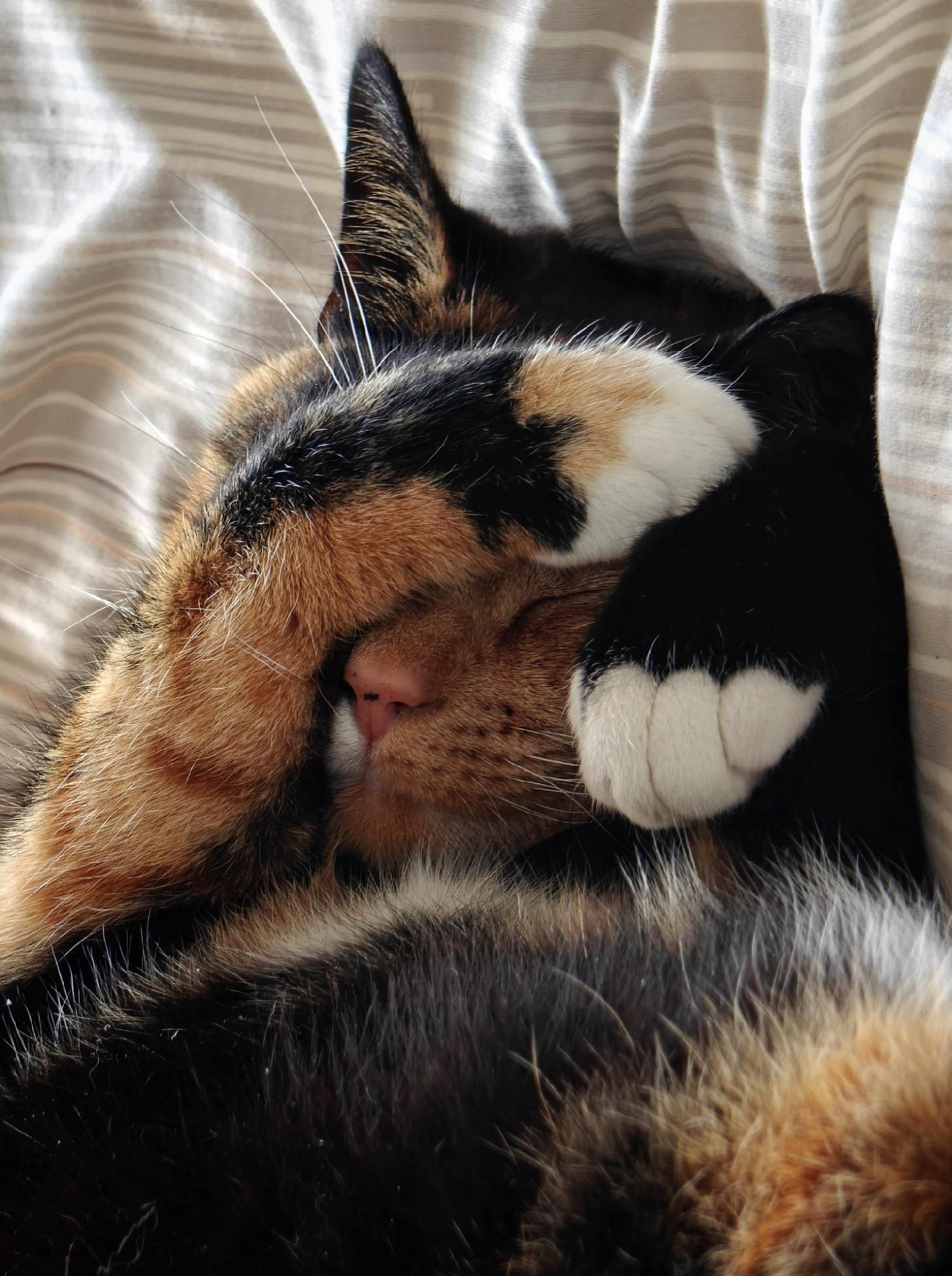#photography nerdity:
-
First, since you're gluing together multiple images, you obviously don't want the subject moving between captures. Buildings (except during, say, earthquakes) are well suited to this as subjects, but you also want to make sure that any people, cars, etc, don't appear in more than one of the component images.
You also don't want the camera moving around. That is, you want the component images to be from as close to the same perspective as possible. This is where it gets interesting.
2/
Basically, the more the perspective changes among the components, the more geometric transformation the software has to do in order to line up the edges to tile them together. And any transformation comes at the expense of resolution and distortion of other parts of the final image.
So the first thing you want is a tripod placed in a single position to make the component captures. That's essential - but still not completely sufficient - for maintaining a fixed perspective
3/
-
 undefined oblomov@sociale.network shared this topic
undefined oblomov@sociale.network shared this topic
-
Basically, the more the perspective changes among the components, the more geometric transformation the software has to do in order to line up the edges to tile them together. And any transformation comes at the expense of resolution and distortion of other parts of the final image.
So the first thing you want is a tripod placed in a single position to make the component captures. That's essential - but still not completely sufficient - for maintaining a fixed perspective
3/
Once you've selected where the tripod goes, the simplest thing to do is pan and tilt the camera on the tripod head between captures, pointing it at different areas of the subject such that there's some overlap between captures.
For best results, this must be done with the camera mounted on the tripod head in a way that the tilting and panning pivots around the central "nodal point" of the lens. Otherwise, the camera is effectively moving its position, even if the tripod itself isn't.
4/
-
Once you've selected where the tripod goes, the simplest thing to do is pan and tilt the camera on the tripod head between captures, pointing it at different areas of the subject such that there's some overlap between captures.
For best results, this must be done with the camera mounted on the tripod head in a way that the tilting and panning pivots around the central "nodal point" of the lens. Otherwise, the camera is effectively moving its position, even if the tripod itself isn't.
4/
Finding the nodal point can be tricky. There are special rigs for this that move the camera on the tripod head to make this easier and more systematic and repeatable.
But even with the panning and tilting done at the exact nodal point, the software still has to do considerable, resolution eating, transformation. To create a rectangular final image, each component has to be stretched at one edge or squeezed at the other, murdering pixels in the process. But results can still be pretty good.
5/
-
Finding the nodal point can be tricky. There are special rigs for this that move the camera on the tripod head to make this easier and more systematic and repeatable.
But even with the panning and tilting done at the exact nodal point, the software still has to do considerable, resolution eating, transformation. To create a rectangular final image, each component has to be stretched at one edge or squeezed at the other, murdering pixels in the process. But results can still be pretty good.
5/
To avoid having to do any transforms at all, you need to capture the component images without moving the camera AT ALL. No panning, no tilting.
But with most cameras, that would mean every component would be of exactly the same image. There'd be nothing to stitch together!
Enter the "technical camera", which is what I generally use for making stitched images.
6/
-
To avoid having to do any transforms at all, you need to capture the component images without moving the camera AT ALL. No panning, no tilting.
But with most cameras, that would mean every component would be of exactly the same image. There'd be nothing to stitch together!
Enter the "technical camera", which is what I generally use for making stitched images.
6/
A technical camera provides internal "shift" movements that move the sensor (or film) with respect to the lens. That is, the lens (which is what determines perspective) stays in one place, but the sensor (or film) can be moved left, right, up, or down.
This effectively moves where the center of the captured image is. So if you make one photo, then shift the sensor to the left and make a second, the two photos together capture a "wide" view of the subject but with no change in perspective.
7/
-
A technical camera provides internal "shift" movements that move the sensor (or film) with respect to the lens. That is, the lens (which is what determines perspective) stays in one place, but the sensor (or film) can be moved left, right, up, or down.
This effectively moves where the center of the captured image is. So if you make one photo, then shift the sensor to the left and make a second, the two photos together capture a "wide" view of the subject but with no change in perspective.
7/
Technical cameras are specialized devices, and they need special lenses that can "cover" - project an image onto - an area larger than the sensor (to allow the shifting). All this is makes everything bigger, heavier, and more expensive. But they allow for making stitched composites without reducing the resolution or distorting geometry the way you'd have to when you capture the components by panning or tilting the whole camera.
8/
-
Technical cameras are specialized devices, and they need special lenses that can "cover" - project an image onto - an area larger than the sensor (to allow the shifting). All this is makes everything bigger, heavier, and more expensive. But they allow for making stitched composites without reducing the resolution or distorting geometry the way you'd have to when you capture the components by panning or tilting the whole camera.
8/
I generally use a Phase One (medium format) digital back on a Cambo "WRS" camera for making my stitched images. This system provides a fair amount of room for movements.
But there are less expensive and cumbersome alternatives. For 35mm-format, both Canon and Nikon make a few "perspective control" (sometimes called "Tilt/Shift") lenses that can be used for this technique on an existing DSLR or mirrorless camera.
9/
-
I generally use a Phase One (medium format) digital back on a Cambo "WRS" camera for making my stitched images. This system provides a fair amount of room for movements.
But there are less expensive and cumbersome alternatives. For 35mm-format, both Canon and Nikon make a few "perspective control" (sometimes called "Tilt/Shift") lenses that can be used for this technique on an existing DSLR or mirrorless camera.
9/
The 35mm shifting lenses aren't absolutely theoretically ideal for this. They generally shift the lens rather than the sensor when the camera is mounted on a tripod, changing perspective with each shift. But the change of perspective between captures is very small, and barely an issue in the final result. And they provide a much less expensive alternative to a full technical camera system.
If this sounds fun, I suggest renting a shifting lens and playing around with the technique.
10/10
-
The 35mm shifting lenses aren't absolutely theoretically ideal for this. They generally shift the lens rather than the sensor when the camera is mounted on a tripod, changing perspective with each shift. But the change of perspective between captures is very small, and barely an issue in the final result. And they provide a much less expensive alternative to a full technical camera system.
If this sounds fun, I suggest renting a shifting lens and playing around with the technique.
10/10
Thanks for the great thread!
During my conscription (in 1980) I learned by myself how to use the Linhof 8×10" of the military school, without any clue, just making experiments.
But since film was expensive, I often had to resort to thin tracing paper
 on the film plate to make correct drawings of devices for manuals (to make them was my "official" duty).
on the film plate to make correct drawings of devices for manuals (to make them was my "official" duty). -
The 35mm shifting lenses aren't absolutely theoretically ideal for this. They generally shift the lens rather than the sensor when the camera is mounted on a tripod, changing perspective with each shift. But the change of perspective between captures is very small, and barely an issue in the final result. And they provide a much less expensive alternative to a full technical camera system.
If this sounds fun, I suggest renting a shifting lens and playing around with the technique.
10/10
Related: Shift is also (more often) used to maintain geometric accuracy in certain subjects even in non-stitched images. It's the secret weapon of architectural photography. Here's a little thread I did on it a while back.
-
Related: Shift is also (more often) used to maintain geometric accuracy in certain subjects even in non-stitched images. It's the secret weapon of architectural photography. Here's a little thread I did on it a while back.
Also, whenI use the term “quality” here, I’m using it a strictly technical sense to refer to the fidelity of the image, not the aesthetic qualities of the image. I very much dislike this usage, but it’s fairly standard in discussing this stuff.



